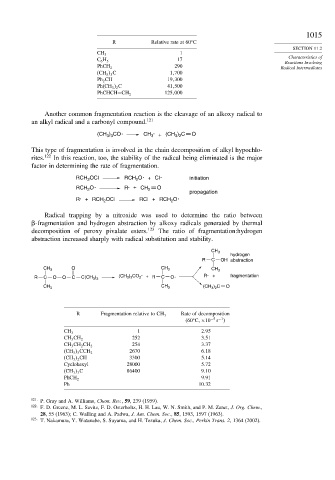Page 1031 - Advanced Organic Chemistry Part A - Structure and Mechanisms, 5th ed (2007) - Carey _ Sundberg
P. 1031
1015
R Relative rate at 60 C
SECTION 11.2
1
CH 3
Characteristics of
17
C 6 H 5
Reactions Involving
290
PhCH 2 Radical Intermediates
(CH 3
3 C 1 700
Ph 2 CH 19 300
Ph(CH 3
2 C 41 500
125 000
PhCHCH=CH 2
Another common fragmentation reaction is the cleavage of an alkoxy radical to
an alkyl radical and a carbonyl compound. 121
(CH ) CO CH 3 + (CH ) C O
3 2
3 3
This type of fragmentation is involved in the chain decomposition of alkyl hypochlo-
rites. 122 In this reaction, too, the stability of the radical being eliminated is the major
factor in determining the rate of fragmentation.
RCH OCl RCH O + Cl initiation
2
2
O R + CH O
RCH 2 2
propagation
R + RCH 2 OCl RCl + RCH O
2
Radical trapping by a nitroxide was used to determine the ratio between
-fragmentation and hydrogen abstraction by alkoxy radicals generated by thermal
decomposition of peroxy pivalate esters. 123 The ratio of fragmentation:hydrogen
abstraction increased sharply with radical substitution and stability.
CH 3
hydrogen
R C OH abstraction
O
CH 3 CH 3 CH 3
R C O O C C(CH 3 ) 3 (CH 3 ) 3 CO 2 + R C O R + fragmentation
CH 3 CH 3 (CH 3 ) 2 C O
R Fragmentation relative to CH 3 Rate of decomposition
s )
(60 C ×10 −5 −1
1 2 95
CH 3
252 3 51
CH 3 CH 2
254 3 37
CH 3 CH 2 CH 2
2670 6 18
(CH 3
3 CCH 2
(CH 3
2 CH 3300 5 14
Cyclohexyl 28000 5 72
(CH 3
3 C 86400 9 10
9 91
PhCH 2
Ph 10 32
121
P. Gray and A. Williams, Chem. Rev., 59, 239 (1959).
122 F. D. Greene, M. L. Savitz, F. D. Osterholtz, H. H. Lau, W. N. Smith, and P. M. Zanet, J. Org. Chem.,
28, 55 (1963); C. Walling and A. Padwa, J. Am. Chem. Soc., 85, 1593, 1597 (1963).
123
T. Nakamura, Y. Watanabe, S. Suyama, and H. Tezuka, J. Chem. Soc., Perkin Trans. 2, 1364 (2002).

